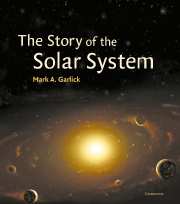Part 2 - Emergence of the Sun's Family
Published online by Cambridge University Press: 10 November 2009
Summary
The planets, their moons, the asteroids and the comets – all are part of the Sun's family. And they are just as ancient as their parent. Evidence suggests that the Solar System's contents started to form even while the Sun itself was still only a protostar, almost as soon as the Solar Nebula was in place.
We have seen that, in some ways, the Sun formed in much the same manner in which a sculpture is made. What began as a single, large block of material – the giant molecular cloud – was gradually whittled away to reveal a smaller end product. But the planets' origins are more like those of buildings. They grew bit by bit, from the bottom up, by accumulating steadily larger building blocks. The very first process in the planet-building production line is a familiar concept known as condensation. You can see it in action when somebody wearing spectacles enters a warm room after being outside in the cold. As soon as air-borne water molecules hit the cold lens surfaces, the molecules cool down and stick to the lenses one at a time to produce a thin – and very annoying – film of tiny water droplets. Exactly the same phenomenon was big business in the very earliest stages of the Solar Nebula. As more and more material spiralled from the Solar Nebula into the newly forming Sun, the disc grew less dense.
- Type
- Chapter
- Information
- The Story of the Solar System , pp. 24 - 25Publisher: Cambridge University PressPrint publication year: 2002



